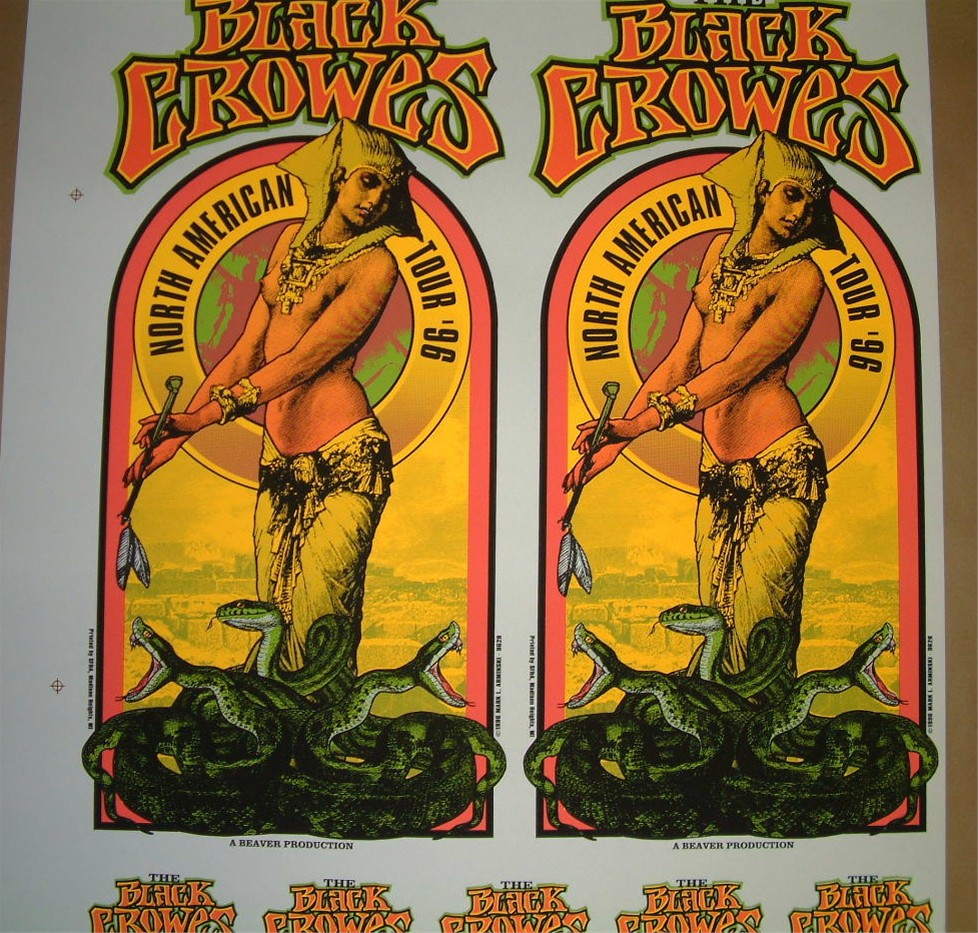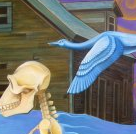Last year the student AIGA group from Specs Howard School of Media Arts, and I took a field trip to the Russell Industrial Center in Detroit. We had the privilege of meeting Mark Arminski. Arminski a local Detroit artist who bridged the gap between the psychedelic 60’s and grudge of the 90’s.
Arminski is an artist who works traditionally, painting or screening concert posters and whatever commissions he receives. He has done advertising work for large corporations, including liquor and cigarettes yet the concert poster is what he is most known for.
Mark was very inspiring and warm, he welcomed the group in and said come back any time. The students were thrilled to here him talk about his design concept of painting and hand lettering, which he felt gave him the most freedom to shape the communication.
In an interview Arminski talks about the ability for many people to create art because of the internet, and the ability to reach a far greater audience. As well as the open ability to sell art, that without the internet artists would be creating with a limited market. [1]
While Arminski recognizes some of the merits of working with the computer, his work is done by hand. He exudes creation in whatever form grabs his attention. The first image is a poster, and the second a snippet of an oil painting he was working on the day we visited.
http://www.arminski.com/shop/my-dream/
Another Motown designer who later transplanted to teach at Cal Arts is Ed Fella. Fella is well-known for his explosion of self-expression in the 1980s when much of the design world was sticking with the clean lines and clear communication of International or Swiss style.
Fella brought authorship back into design as each of his pieces were hand created by hand and very self expressive. Before Fella attended Cranbrook for his Masters, he worked in the advertising world even while he was working in advertising he would often draw little political pieces for himself to hand around the office.
In an Interview for Designer People, Fella talks about doing all his work by hand, with color pencils, ball point pens and crayons. He also works with a waxer and knife, he cuts and pastes. His lettering is by hand, as he says “of course he letters everything by hand.” He was considered to have brought the craft back to design in a time of the introduction of the computer. Fella also feels that working by hand offers him the most flexibility. [2]
Both Fella and Arminski cited flexibility as a major reason for creating using traditional methods. Arminski has adopted the computer for certain aspects such as selling and networking. Both designers are illustrative more over production designers and so this seems fitting that they would create using traditional methods. I feel that designers have to have some ability to drawing to be fully successfully. Whether it be the ability to do a napkin sketch, a thumbnail or a full illustration. There are certain skills developed by putting pencil to paper.
Also artist get lost in the process. For some designers this may mean working a photo composition in Photoshop, while for others it means getting lost in the paint or pencil marks being made.
In the samples I found the end results were very successful and the outcome not hindered by the process of traditional methods.
There seems to be an interesting dichotomy regarding computer art and traditional art. Some computer artist feel they do not need to use traditional methods to create – ever. Yet once they begin to feel confident in their skills, the idea of sketching becomes easier to reach for. And reversely once a traditional artist puts something into the computer to manipulate the end result they also fall in love with new possibilities.
Young designers have grown up with computers and may feel a disconnect between art and design. To encourage them to doodle and use that as part of a design solution, or graffiti opens new doors. For the seasoned designer perhaps acclimated to the speed of the computer process, yet feeling less fulfilled, a return to traditional methods could infuse the designer with renew passion for the field.
Creatives need to create. Experiment. Get their hands dirty. Bringing art and computer together often offers a warm, organic solution to a design challenge. Sitting in front of a computer ten hours a day or allowing the computer to be the designer stifles humans. We have to remind ourselves and those we mentor that the computer is just another tool in the designers belt.
Resources:
http://www.arminski.com/
[1] http://www.arminski.com/photos-media/being-an-artist-in-a-digital-world/
[2] http://vimeo.com/8868251, Interview for Designer People



![9354600[1]](http://victoriashepherd.net/wp-content/uploads/2012/08/93546001.jpg?w=239)